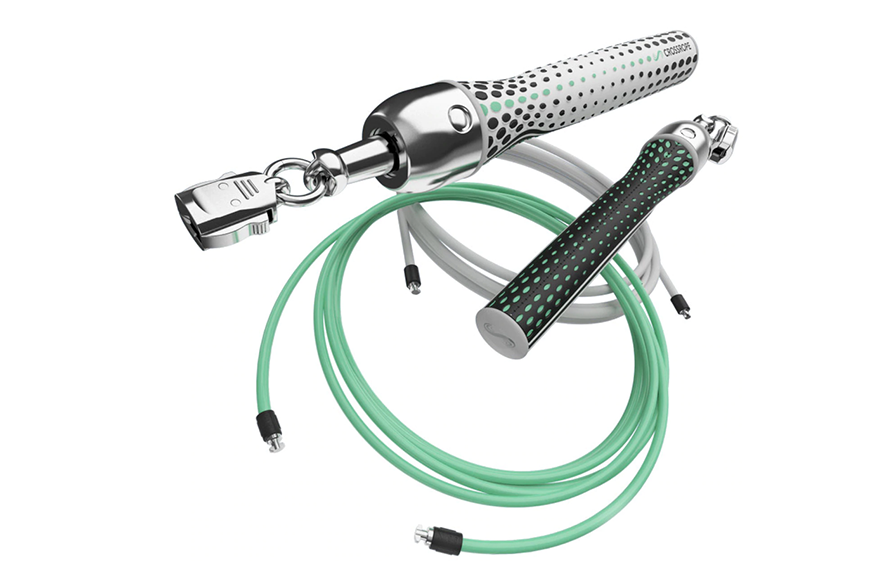Trainers Agree: Jumping Rope Is One of the Best Forms of At-Home Cardio
When it comes to stellar at-home workouts, we often think of video-led bodyweight sequences, simple dumbbell moves, a heart-pumping dance sesh, or heading out for a run. While all of these exercises undoubtedly benefit the body, none of them offer quite as much utility (and agility) as jumping rope.
If you haven’t jumped rope since your elementary school’s Jump Rope for Heart fundraiser, don’t worry. We chatted with a few jump rope pros for everything there is to know about stepping into a routine, including the secret to perfect each jump and why it’s worthwhile in the first place.
- Chris Gagliardi, CPT, California-based personal trainer
- Krissy Cela, Krissy Cela is a co-founder and trainer with Tone & Sculpt, a subscription-based digital fitness app.
- Michael Olajide Jr., Michael Olajide Jr. is a former championship boxer and current trainer with Centr, Chris Hemsworth's digital fitness platform.
The benefits of jumping rope
As simple as jump roping may have seemed when you were a child, there’s a pretty good chance it will be anything but as you step back into it. “Jumping rope gives you a full-body cardio burn because you use every muscle in the body simultaneously,” says Michael Olajide Jr., a Centr trainer and former championship boxer. As a result, it raises your heart rate—and keeps it there. “Not only is it energizing, but it’s also time-efficient, so it's a great workout for busy people. You have to run for 30 min to equal the benefits of a 10-minute jump rope workout," says Chris Gagliardi, ACE-certified personal trainer.

{{post.sponsorText}}
In addition to its cardio-boosting effects, jumping rope gets a gold star for affordability. “It’s cheap and can be done anywhere,” says Krissy Cela, Tone and Sculpt co-founder and trainer. “Once you’ve purchased your jump rope, every workout is effectively free. Plus, the jump rope is small enough to fit in any bag, and given you can take it anywhere, it means you can skip anywhere as long as you have space to swing the rope."
Lastly, Olajide points out that jumping rope also requires a greater mind-body connection. “You have to be present-focused and extremely aware of everything you're doing the whole time,” he says. “Every time you’re not, the rope lets you know by catching your foot.”
How to become better at jumping rope
As with pretty much anything, trainers agree that perfecting the art of the jump rope comes down to practice, practice, practice. “Before trying any other moves, the best thing you can do is make sure you can jump the basic jump [both feet bouncing at the same time] for three-to-five minutes without a huge effort,” says Olajide. “This means you have the motor skills mastered and you won’t get tired."
Part of perfecting the basic jump—and eventually becoming a better jumper overall—requires mastering proper form. “Make sure you have a slight knee bend and soft landing after each jump,” says Openfit Ladder trainer, Kelsey Hennan, adding that you should focus on bouncing on the balls of your feet. Additionally, you'll also want to swing the rope with care. “A common thing people will do when starting out is to swing the rope with their hands far away from their body, using the full arm to rotate the rope,” she explains. “This will slow you down and cause your shoulders and arms to fatigue more quickly.” Instead, she says to slightly bend your elbows and swing using only your wrists. “Keep your wrists six to 12 inches away from your body, aligned with your hips,” she adds, noting that, when it comes to jumping rope, it’s all in the wrists.
Jump rope moves to try
One of the best parts about jumping rope is the fact that there are so many ways to switch things up. To do so, consider weaving the following jumps—which are listed from the most basic to pro-level advanced—into your routine.
1. Skipping rope
“This is a staple to have in your jump roping repertoire,” Hennan says. “Instead of jumping with both feet together, this variation has you shift your weight from leg to leg as you alternately lift each foot in front of you.”
2. Boxer Step
This boxer-inspired move involves switching your weight between feet, with one foot firmly planted on the ground and the other propped on a light toe-tap. “Alternate from side to side as you continue jumping, putting the weight on one side at a time,” says Hennan. “Left plant, right touch, then right plant, left touch.”
3. High knees
As it sounds, this jump is all about lifting your knees up to waist height as if you’re running in place. “Alternate which leg you are driving up to your waist level while continuing to jump rope,” says Cela. “It really engages your core and drives up your heart rate at the same time. As you progress in this move, you can increase your speed.”
4. Mummy kicks
Ready to add intensity and skill? Cela says to keep your legs straight and alternate kicking one leg out in front of you at a time, all while continuing to jump rope.
5. Jacks
If you’re confident in your coordination, Hennan says to jump in jack formation alternating between feet together and feet apart.
6. Crossovers
Instead of jumping through an open-armed rope, Olajide says to try jumping through a crossed rope. “Start by jumping the basic jump for an eight count,” he instructs. “Then on the count of one, cross your arms in front of your body, on two uncross your arms and continue the basic jump until you reach eight.” Continue to cross on one and uncross on two as you keep up the jump.
7. Side-side aero
You may have seen this move at Jump Rope for Heart as a tricky rest jump. In reality, Olajide says it takes maximum coordination. “You have to be aware of where the rope is at all times and jump with intent to get over the rope,” he explains. “Grab the handle of the rope in each hand, then bring your hands together. Keep your hand's waist level. They should move as one. Turning your wrist and upper body, move your hands in a sideways figure eight. The end of the rope and your hands should move as one. This move should be done on a three count. Swing both hands to the right (on one) Swing both hands to the left (one two) Keep the left hand on the left side bring the right hand to the right side, open the rope and jump over it (on three).” And repeat.
8. Side aero
Once you’ve nailed the side-side aero, Olajide suggests taking it a step further. “This is like the side-side aero but you have to think faster,” he says. “This move is executed on a two count. Both hands together swing to the right (on one) then leave the right hand on the right-hand side and bring the left hand back to the left-hand side, opening the rope which you will then jump over (on two).” Repeat the jump pattern, switching from side to side.
9. Ankle touch
According to Olajide, this is one of the best possible ways to use the rope for the sake of toning your legs. To achieve that definition, he says to execute the basic jump with your feet about three inches apart while you jump. “As you jump up, your ankle and foot quickly touch and then open back to three apart as you land.”
10. Double under
Ready for the coup de grâce? Instead of passing your rope under your feet once per jump, Hennan says to go for two. “Jump twice as high as when you do a basic jump and turn the rope twice as fast so the rope passes under your feet twice before you land,” she says.
Jump ropes worth investing in
1. Guard & Revival Treat Speed Jump Rope, $19
This rope is great for jumpers of all levels thanks to a ball-bearing mechanism inside its handles that makes for smooth swinging. Plus, it's adjustable, so you can ensure that you'll get the perfect length-to-height ratio for your body.
Shop now: Guard & Revival Treat Speed Jump Rope, $19
2. Crossrope Get Lean Weighted Jump Rope Set, $99
Heavier ropes make for easier jumping (they help you swing more steadily and keep your muscles engaged), and this one comes in one-fourth pound and one-half pound versions so that you can find what works for you.
Shop now: Crossrope Get Lean Weighted Jump Rope Set, $99
3. TANGRAM Smart Jump Rope Rookie, $40
This techy rope connects with an app on your phone or Apple Watch so that you can track your workout data. It measures things like jump count and time spent jumping so that you'll know how much you're improving.
Shop now: TANGRAM Smart Jump Rope Rookie, $40
For more jump roping tips, check out this Well + Good tutorial courtesy of Amanda Kloots.
Oh hi! You look like someone who loves free workouts, discounts for cult-fave wellness brands, and exclusive Well+Good content. Sign up for Well+, our online community of wellness insiders, and unlock your rewards instantly.
Loading More Posts...


